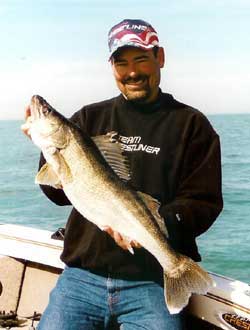
If there was ever a perfect time for tying into a monster walleye the early fall period would top the list. That’s not to say you can’t catch a fish of mammoth proportions at other times of the year because you can, it’s just that right now is when everything seems to come together and the odds start tilting heavily in your favor.
For one thing the question of whether or not you’re dealing with active fish at any given time is basically answered with a resounding yes. Right now old marble eyes instinctively knows that he is running out of time and being finicky won’t get the job of putting on thick layers of fat to get through the winter period done. That fact alone accounts for most of the “odds factor” and is definitely something to take advantage off.
Another endearing aspect of targeting fall fish is their propensity to set up on quick breaking structure where they are easily found with good electronics. A high definition digital graph like the Raymarine C120 with its massive 12″ color screen can help make the task a lot easier and can easily pick out those fish holding tight to a break. It also doubles as a GPS chartplotter that can display Navionics maps and where you are in relation to it all which can save tons of valuable fishing time. Instead of running and searching and running and searching you can actually see what you’re looking for on the C120’s color display and make a bee line for the exact spot you want to check out.
Hot fall spots include sharp breaks that drop into deeper water, and are similar patterns found in natural lakes as well as reservoirs. Big reservoirs like Lake Oahe in South Dakota see heavy concentrations of walleyes stacking up on outside bends of the old river channel where it pulls in tight to the bank. Gull Lake in north central Minnesota is another tremendous producer of fall hawgs which are typically found holding on sharp breaks off main lake structure. That scenario repeats itself over and over again across the entire country which helps to keep it all rather simple.
A quick look at a good map will reveal the areas likely to hold the lion’s share of fall hawgs, ultimately leaving you with more angling time which can then be spent concentrating on high percentage spots. If you’re looking at a big reservoir try to find fast breaks and deep water up major creek arms. On lakes like Gull look for quick breaks on sunken humps and under water points as well as inside turns along shallower shoreline shelves or flats.
 Once you’ve found a few starting spots the next item on the agenda is presentation and there are several options and includes live bait rigging and jigging. Another hot fall technique that is often overlooked is trolling those aforementioned break lines with crankbaits, especially the larger variety. Big fish will take a big bait and the bigger the better when you’re chasing down real monsters.
Once you’ve found a few starting spots the next item on the agenda is presentation and there are several options and includes live bait rigging and jigging. Another hot fall technique that is often overlooked is trolling those aforementioned break lines with crankbaits, especially the larger variety. Big fish will take a big bait and the bigger the better when you’re chasing down real monsters.
Baits like Deep Husky Jerks or Deep Tail Dancers are a good bet for hooking up with deeper running daytime fish. The new Deep Tail Dancer for example can be worked down to thirty feet on monofilament, which will get you into the range of most of the good fall hot spots. If needed, a braided line can help you to pick up another ten feet or so and lead core will cover every depth from top to bottom.
Anglers working the night shift should take a look at the same areas but concentrate their time on the very top of the quick breaks. A typically scenario includes active walleyes holding deep during the day and moving up shallow to the top edge as the sun goes down and even spreading out across shallower flats. The top edge is a concentration point and a staging area for hungry eyes on a serious feeding mission.
Chasing the night run requires a variation in bait selection and is where shallower running baits like the Husky Jerks and Original Floating Rapalas come in. What remains the same is size and includes #12’s and 14’s in the Husky Jerks and #18 in the Floating Rapalas.
Trolling speed is another key to nailing fall hawgs and slow may be the first thing to come to mind but is not always the case. Early in the fall period water temperatures are still warm enough to allow for a quicker pace, like up to 2 ½ to 3 ½ mph. Those are speeds that my 250hp Direct Injection Evinrude main motor can easily handle, all which allows me to cover plenty of potential hawg holding ground.
Later in the season when things really cool off you may have to slow it way down to still get hit, or even pick up the rigging or jigging rod, but not now. Now is the time for big baits, plenty of speed, and a few fall hawgs.










